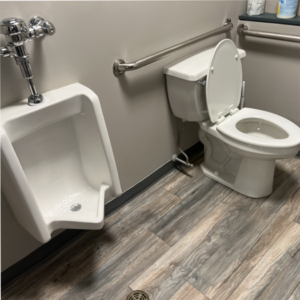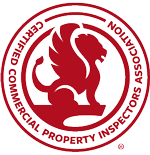A standard commercial property inspection according to the ComSOP should include the visual inspection of permanently installed restrooms throughout the property. While this is generally a visual-only inspection, the general operation of some fixtures, devices, valves, and stoppers is typically required using basic manual techniques in order to test their normal functionality. Any fixture or system that has been dismantled or, in the opinion of the inspector, will cause damage or harm if activated, should not be operated.
There are common elements of a restroom which can be highlighted for your clients. Some of these elements are also common to other areas of the subject property and may be noted in different sections of your inspection report. Examples of these include the floors, walls, doors, ceilings, and windows. (For the purposes of this article, these other sections have been excluded.)
Toilets, Urinals, and Bidets
The inspection of these devices will require operation of the flush and/or fill systems. These could be automatic sensors initiated through movement or by using an installed handle. A representative number of toilets, urinals, and bidets should be operated and flushed.
Common issues found include:
- poor installation;
- loose fixtures at the floor or wall attachment;
- leaking;
- poor water fill;
- slow water fill;
- unusual sounds;
- wrong water temperature;
- missing elements; and
- visual damage.

Toilet and Urinal
Sinks
Most restrooms have some sort of fixture for hand-washing, such as a basin with both hot- and cold-water sources. The function of the hot and cold water should be verified. In addition to the operation of the water source, there should also be a permanently installed method of draining. Inspectors should perform a water flow test of a representative number of sinks for their functional drainage. Sinks must be supported and securely attached to the wall.
Common issues found include:
- loose attachment of fixture to wall and/or at base;
- reversed water sources;
- missing hot water;
- missing cold water;
- leakage in drain system;
- missing stopper in drain system; and
- racks or other visible damage.

Restroom Sinks
Showers and Tubs
Tubs and showers are not just present in residential properties but can also be found at commercial properties. These fixtures require operational and drainage testing, in addition to a general visual inspection. This inspection should include the integrity of the walls and surround, water supply, drain system, and any other installed element.
Common issues found include:
- poor water supply;
- reversed water supply valves;
- soft walls or surrounds;
- inward swinging doors;
- poor drainage;
- missing safety glass; and
- missing or failed plumbing elements (handles, valves, showerheads, etc.).
Ventilation
All restrooms require ventilation. This could be provided with individual units or through a central ducted system. Bathrooms and spa rooms may have specific requirements due to the amount of moisture that can be created in those areas. This ventilation system must exhaust from the building to the exterior, and not into an interior or confined space.
Common issues found include:
- excessive noise or vibrations;
- moisture staining;
- failure;
- exposed electrical elements;
- excessive dirt or debris;
- improper discharge point; and
- missing elements (removed or not originally installed).
Other Installed Features and Apparatuses
Restrooms can have several other installed features or apparatuses that will require an inspector’s opinion or review. These can include (but are not limited to) towel dispensers, mirrors, hand dryers, and partition walls. Each of these items will require a general inspection to test their normal functionality.
Common issues found include:
- loose mounting;
- broken or missing elements;
- cracked glass; and
- old with disrepair.

Dryer Defect
Access and Signage for Public Restrooms
Public toilet facilities should have a readily visible sign located near the entrance directing people to each facility, and designated by gender use, if applicable. Directional signage indicating the route is usually posted in lobbies, corridors, aisles, and similar spaces near the main entrance or tenant space. The route to access the public restrooms should not pass through kitchens, storage rooms, or closets, but from within the building or from the exterior. Additionally, toilet rooms are prohibited from opening directly into a room used for the preparation of food for service to the public. Restrooms also have specific accessibility requirements. Refer to Section 15 of the ComSOP: Accessibility for details. Note that reporting on general access and signage is beyond a baseline commercial property inspection.
Takeaway for Commercial Property Inspectors
Commercial property inspectors are required to perform a visual inspection of permanently installed restrooms. In addition to the visual inspection of the condition of restrooms and their related components and fixtures, inspectors should test a representative number of fixtures found in restrooms for operation and drainage as applicable, including toilets, sinks, faucets, tubs, and showers, and then report on them accordingly. Additionally, inspectors may choose to assess the ADA-compliance of the restrooms’ accessibility. This is particularly important for restrooms used by the general public.
Article Written By: Rob Claus, CMI®
Additional Commercial Property Inspector Resources:


